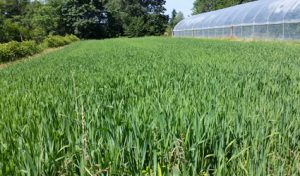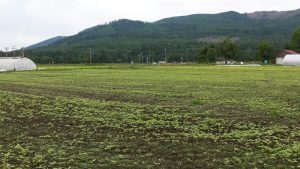 Most folks know that winter cover crops like rye and vetch can be a huge benefit to their soils. Winter cover crops benefit their crops by providing soil cover to prevent erosion, keep valuable nutrients cycling through the microbiome below the soil surface, suppress weeds, fix nitrogen for spring plantings, and provide a break in pest and disease cycles. Once you’ve experienced the satisfaction and joy of the tilth that comes with good cover cropping, you’ll be interested in how you can take advantage of the smallest windows of downtime in your garden, whether it’s a half an acre, a single bed, or even just the spaces between established crops.
Most folks know that winter cover crops like rye and vetch can be a huge benefit to their soils. Winter cover crops benefit their crops by providing soil cover to prevent erosion, keep valuable nutrients cycling through the microbiome below the soil surface, suppress weeds, fix nitrogen for spring plantings, and provide a break in pest and disease cycles. Once you’ve experienced the satisfaction and joy of the tilth that comes with good cover cropping, you’ll be interested in how you can take advantage of the smallest windows of downtime in your garden, whether it’s a half an acre, a single bed, or even just the spaces between established crops.
We’ll take every chance we can to sneak some soil building in no matter the time of year. This summer we have nice stands of spring oats and buckwheat. The oats provide tremendous weed suppression from very early on in the season if you have the space and work when the soil temperature is too low for summer covers like buckwheat or sorghum sudan grass. Oats also have the capacity to produce 10,000 lbs of dry matter per acre, which if you cut them at the right time, could also give you as much as 50 lbs of nitrogen (N) for a fall crop of brassicas, or clean ground for your garlic in October. With oats planted early enough, you can let them grow to maturity, harvest the grain for your chickens or goats, then turn the oats you left in the field with one quick pass of the tiller (or other soil stirring implement) and plant garlic as soon as the new stand of oats is killed by the first hard frost. Throw some clover into that mix and you might have cover between your rows all winter long, with a little trickle of N every time you mow!
Buckwheat is a very fast-grower who isn’t related to anything else you might be cropping (unless you’re growing sweet potatoes). Buckwheat is one of the best cover crops to make phosphorous plant available. Buckwheat’s root exudates have a way with phosphorus that few other plants share; in addition buckwheat is excellent for suppressing summer weeds and is a good source of nectar for pollinators and beneficial bugs. Buckwheat can be mowed and turned in with just 6 weeks in peak season giving 2 to 3 tons of dry matter per acre. It also makes a great nurse crop for slower growing summer grass covers such as sorghum sudangrass—just plant them both at the same time and mow the buckwheat at flowering to watch the sudangrass come thundering up behind for 4 or 5 tons of dry matter and the possibility for as much as 9 tons with fertile soil, adequate moisture, and multiple cuttings.
Crimson clover is another great cover most folks think of in winter mixes but in summer will establish more quickly and fully and can be mowed in pathways all summer to provide a N rich mulch every time you weed.


